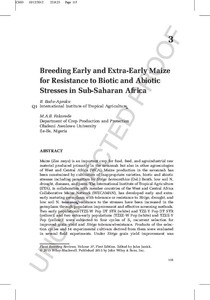| dc.contributor.author | Badu-Apraku, B. |
| dc.contributor.author | Fakorede, M.A.B. |
| dc.date.accessioned | 2019-12-04T11:07:49Z |
| dc.date.available | 2019-12-04T11:07:49Z |
| dc.date.issued | 2013-04 |
| dc.identifier.citation | Badu-Apraku, B. & Fakorede, M.A.B. (2013). Breeding early and extra-early maize for resistance to biotic and abiotic stresses in sub-Saharan Africa. In J. Janick, Plant Breeding Reviews, Volume 37 (p. 123-205). New Jersey: John Wiley and Sons. |
| dc.identifier.isbn | 978-1-118-49785-2 |
| dc.identifier.uri | https://hdl.handle.net/20.500.12478/1604 |
| dc.description | Published online: 26 March 2013 |
| dc.description.abstract | Maize (Zea mays) is an important crop for food, feed, and agroindustrial raw material produced primarily in the savannah but also in other agroecologies of West and Central Africa (WCA). Maize production in the savannah has been constrained by cultivation of inappropriate varieties, biotic and abiotic stresses including parasitism by Striga hermonthica (Del.) Benth. low soil N, drought, diseases, and pests. The International Institute of Tropical Agriculture (IITA), in collaboration with member countries of the West and Central Africa Collaborative Maize Network (WECAMAN), has developed early and extraearly maturing germplasm with tolerance or resistance to Striga, drought, and low soil N. tolerance/resistance to the stresses have been increased in the germplasm through population improvement and effective screening methods. Two early populations [TZE-W Pop DT STR (white) and TZE-Y Pop DT STR (yellow)] and two extra-early populations [TZEE-W Pop (white) and TZEE-Y
Pop (yellow)] were subjected to four cycles of S1 recurrent selection for improved grain yield and Striga tolerance/resistance. Products of the selection cycles and 14 experimental cultivars derived from them were evaluated in several field experiments. Under Striga grain yield improvement was 70.6 kg ha 1 (6.3%) cycle 1 for TZE-Y Pop DT STR and 352.5 kg ha 1 (58.0%)
cycle 1 for TZE-W Pop DT STR. Under Striga-free environments, improvement was 194 kg ha 1 (6.6%) cycle 1 and 186.5 kg ha 1 (6.0%) cycle 1, respectively. For the extra-early yellow population yield improvement was 90% cycle 1 and
18.41% cycle 1 under Striga-infested and Striga-free environments, whereas the white extra-early population was improved by 12.7% cycle 1 under Striga and 12.91% cycle 1 in Striga-free environments. Striga tolerance/resistance improved significantly in response to selection. The derived cultivars from this program performed equally with or better than the best released cultivars in Striga-free environments. The breeding program also developed stress-tolerant hybrids and quality protein maize (QPM) cultivars with resistance to multiple stresses. Many stress-tolerant/resistant open-pollinated and hybrid cultivars
derived from this program have been released and adopted by farmers in West and Central Africa. For sustained improvement, future efforts should use a multidisciplinary network approach, with establishment of seed companies and development of hybrids as the ultimate goal. |
| dc.description.sponsorship | United States Agency for International Development |
| dc.description.sponsorship | Bill & Melinda Gates Foundation |
| dc.description.sponsorship | Howard Buffet Foundation |
| dc.description.sponsorship | Nippon Foundation |
| dc.description.sponsorship | International Fund for Agricultural Development |
| dc.description.sponsorship | Rockefeller Foundation |
| dc.format.extent | 115-199 |
| dc.language.iso | en |
| dc.publisher | John Wiley and Sons |
| dc.subject | Maize |
| dc.subject | Biotic Stress |
| dc.subject | Abiotic Stress |
| dc.subject | Striga Hermonthica |
| dc.subject | Drought Tolerance |
| dc.subject | Low Soil N |
| dc.subject | Maize Hybrid |
| dc.subject | Open-Pollinated Cultivar |
| dc.subject | Quality Protein Maize |
| dc.subject | Recurrent Selection |
| dc.title | Breeding early and extra-early maize for resistance to biotic and abiotic stresses in sub-Saharan Africa |
| dc.type | Book Chapter |
| dc.description.version | Peer Review |
| cg.contributor.crp | Maize |
| cg.contributor.affiliation | International Institute of Tropical Agriculture |
| cg.contributor.affiliation | Obafemi Awolowo University |
| cg.coverage.region | Africa |
| cg.coverage.region | West Africa |
| cg.coverage.country | Nigeria |
| cg.authorship.types | CGIAR and developing country institute |
| cg.iitasubject | Maize |
| cg.iitasubject | Soil Fertility |
| cg.iitasubject | Soil Health |
| cg.iitasubject | Soil Information |
| cg.howpublished | Formally Published |
| cg.publicationplace | New Jersey, United States |
| cg.accessibilitystatus | Limited Access |
| local.dspaceid | 82372 |
| cg.targetaudience | Scientists |
| cg.identifier.doi | http://dx.doi.org/10.1002/9781118497869.ch3 |

